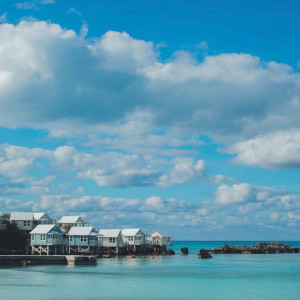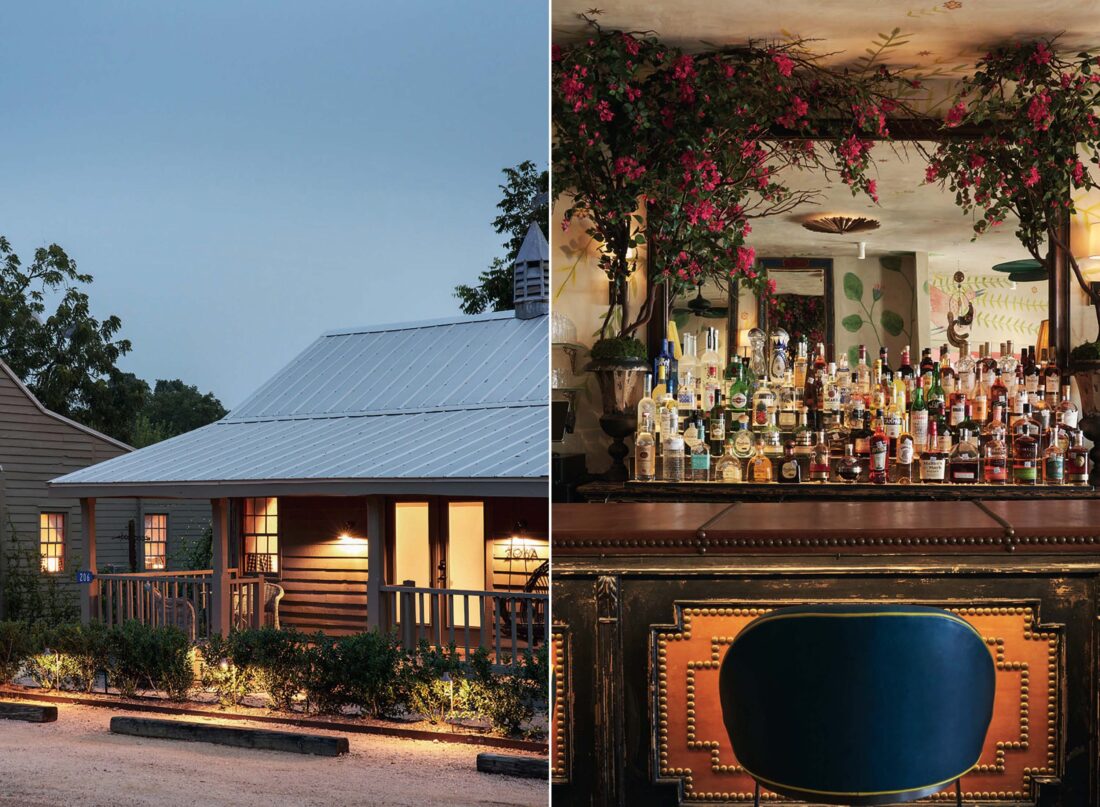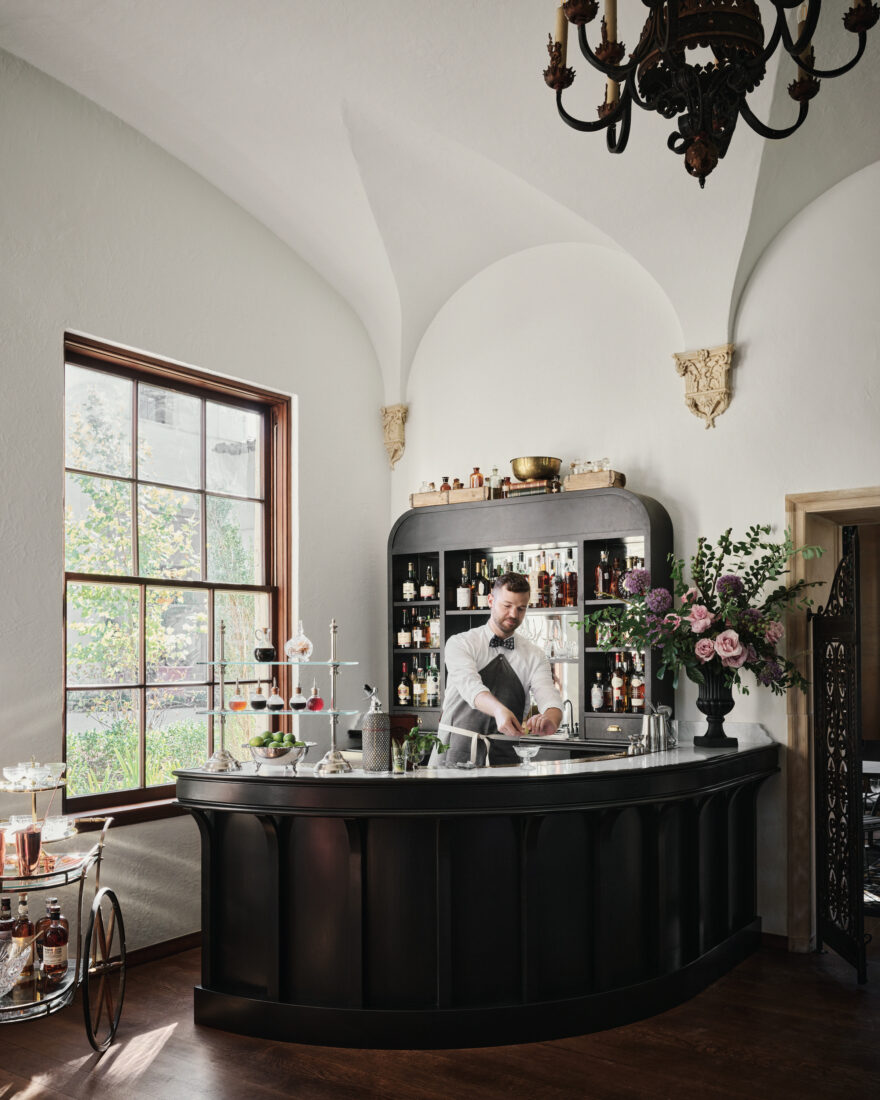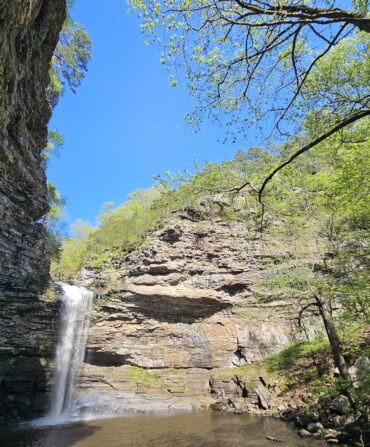Hospitality is big, big business in Texas, which boasts the most hotels of any Southern state (nationwide, it’s second only to California). But it’s not all new construction and city high-rises: Some of the state’s most notable and inviting additions have revitalized once-neglected historic spaces, preserving character and reenergizing downtowns. From an updated midcentury motel in Galveston with a can’t-miss bar, to a gorgeous sprawling estate in Austin, to a collection of nineteenth-century bungalows in Round Top, these hotels artfully merge Lone Star heritage with contemporary flair—and keep their soulfulness intact.


The Commodore Perry Estate
Austin
Visiting the Commodore Perry Estate, part of the Auberge Resorts Collection, feels like being in two places at once. The 1928 Italianate mansion sits on ten acres in the heart of Austin’s Hyde Park neighborhood, but one could easily mistake it for a country home in Europe with its glamorous grounds and manicured gardens. Formerly the residence of Texas businessman Edgar “Commodore” Perry and his wife, Lutie, the landmark reopened in 2020, inviting guests to stay in one of the original mansion suites or a new three-story inn. The Virginia-born designer Ken Fulk appointed the estate in his signature whimsical style, keeping original tile work and wood paneling and mixing in floral paintings, taxidermy, and Pierre Frey fabric depicting cacti with one-of-a-kind furnishings from the Original Round Top Antiques Fair. “It’s my imaginary Hill Country residence,” Fulk says. “There is a childlike sense of wonder about the whole thing.” Guests drift among the restored stained-glass-lined chapel, picnics on the lawn, lazy afternoons by the pool, and cocktail hour in the living room before dinner at Lutie’s, the garden restaurant where stylish Austinites and visitors dine on house-baked bread and platters of Royal Red shrimp and Mississippi Delta–grown rice. —Sallie Lewis

Hotel Lucine
Gavelston
Past the seafood shacks, Pleasure Pier, and mini-golf courses lining Galveston’s seawall, a pylon sign juts from a low-slung brick building. Once bearing a pirate ship and the words TREASURE ISLE MOTEL, the sign now marks Hotel Lucine, signaling a new life for the midcentury seaside motor inn. “We wanted to preserve the soul and history of the building, but modernize it,” says Galveston native Keath Jacoby, who co-owns the Lucine with her husband, Dave, and developer Robert Marcus. “Cities across Texas are growing exponentially, and we want to show that Galveston is on an upward trajectory, too.” Relics from the sixties, the Lucine’s zigzagged roofline and center courtyard remain, but the owners have swapped some of the stucco walls for glass panels, added more bright pops of teals, golds, and greens to the eaves, and decked out the entire courtyard in emerald and white tiles handmade by a family in Nicaragua. (Those colorful tiles repeat throughout the lobby bar, and the sixty-one guest rooms retain much of their original tile as well.) The owners tapped a pair of Houston heavyweights, James Beard Award–winning chef Justin Yu and bar guru Bobby Heugel, to helm the food and beverage program, which orbits around a small but dazzling restaurant, the Fancy. “We want it to feel like you’re eating at an eclectic friend’s house,” Dave says of the restaurant. Yu calls it “fine-ish dining,” accented with Gulf Coast ingredients such as a pork-belly pot roast bobbing with roasted oysters in mignonette. Follow dinner with a nightcap at the rooftop bar, where the lights of the Ferris wheel down the beach glimmer, simultaneously a stone’s throw and a world away. —Caroline Sanders Clements

Hotel Lulu
Round Top

The sound of a rooster crowing starts another day in Round Top, a quiet town with just eighty-seven permanent residents about halfway between Austin and Houston. Every spring and fall, though, it explodes into a treasure hunter’s paradise when more than 100,000 people descend during the Original Round Top Antiques Fair, which draws sellers and buyers from around the country. The town’s lodging options have never come close to meeting the demand. But after forty years of owning a home in Round Top, Cinda Murphy de Palacios and Armando Palacios opened their Hotel Lulu in 2021. “Hotel Lulu captures the magic of our favorite small town,” says Cinda—“Lulu” to her grandchildren. “It combines formal settings in primitive spaces with equal parts Texas hospitality and European sophistication.” Six restored nineteenth-century bungalows—original cedar walls intact—dot a one-acre tract once known as Bybee Square. The name pays homage to Texas doyenne Faith Bybee, the original owner of the dwellings and herself a preservationist. In the fourteen guest rooms, dramatic canopied beds, gilded mirrors, and handwoven blankets from Pakistan’s Cholistan Desert strike a sumptuous and comfortable balance; outside, porch swings await after a day of antiquing. At the Il Cuculo bar, cocktails arrive beneath a hand-painted jungle mural by Houston artist Andrea Condara, and the posh new lounge just beyond, with a malachite wallpaper ceiling, heavy velvet curtains, and an intimate twenty-person capacity, might be the best-kept secret in Texas. —SL

Hotel Dryce
Fort Worth
For Jonathan Morris, opening Hotel Dryce in 2021 in Fort Worth’s Cultural District provided an opportunity to broadcast the city’s creativity. “I love being able to paint a narrative for visitors of there being a new energy in Fort Worth,” says Morris, the hotel’s co-owner and the entrepreneurial host of the Magnolia Network series Self Employed. “It’s not the same old Western cowboy culture people know. We have that, but we’re more than that.” The architects at Bennett Partners transformed a midcentury dry-ice warehouse into a chic and cozy twenty-one-room hotel with a growing collection of local art, such as woven tapestries by Niki Dionne and elegantly moody photographs by Guillermo D. Tapia, both of whom are known to frequent the Dryce’s lobby bar. Located just across the street from Dickies Arena, which hosts A-list musicians as well as the Fort Worth Stock Show & Rodeo, the hotel and its bar draw diverse crowds: Chris Stapleton groupies one night, fans of Post Malone the next, bull-riding buffs another. Out front, a courtyard firepit filled with dry ice—purchased each week from the building’s original occupants—steams like a welcome beacon. —CSC

The Plaza Hotel Pioneer Park
El Paso
In 1930, Conrad Hilton cut the ribbon on his tile-tower-topped hotel in downtown El Paso. The tallest building in the skyline for nearly a quarter century, the Hilton became a city landmark and attracted glamorous patrons; Elizabeth Taylor, for one, lived in the penthouse for nine months while she filmed the 1956 blockbuster Giant in Marfa (she was, after all, married to the hotel magnate’s heir). Many downtown El Paso buildings began to deteriorate in the 1980s and ’90s, but a major restoration effort began in the 2000s. In 2020, after sitting empty for decades, the hotel reopened as the Plaza Hotel Pioneer Park, ringing in a hopeful new age for Sun City. “Our ethos is to bring people back to downtown El Paso,” says Adrian Gonzalez, the property’s general manager. While the original brick-and-concrete facade remains and designers managed to salvage tile work and chandeliers, the interiors received a full upgrade, with new leather, mohair, and walnut furniture; West Texas surrealist art; and relics from the hotel’s history. The lobby’s Ámbar Restaurante serves wood-fired Mexican cuisine that highlights nearby family farms. “You know the food is good when about forty percent of our clientele comes over from Juárez each night,” says Gonzalez, who helps run the vast tequila program that comprises more than six hundred agave spirits. “People know tequila, but we introduce them to sotol, mezcal, bacanora, raicilla.” Upstairs, at the rooftop bar, La Perla, guests can sip those spirits in Mexican mint juleps or mojito diablos as they gaze on the city from Elizabeth Taylor’s point of view. —CSC








